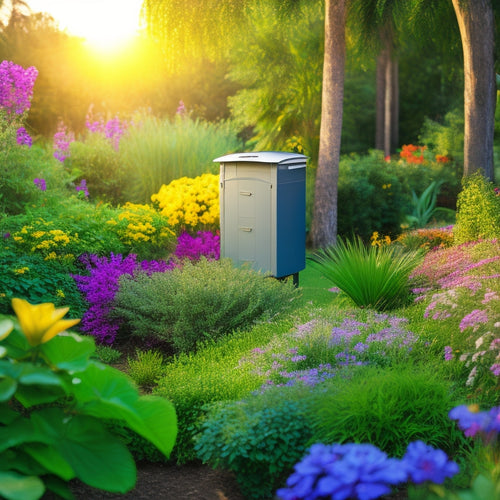
What Does Underground Cistern Installation Involve?
Share
You're about to initiate an underground cistern installation project that involves an extensive 10-step process. It starts with site selection and assessment, where you'll evaluate topography, soil type, and groundwater levels to guarantee a suitable location. Next, you'll excavate and prepare the ground, followed by cistern sizing and selection based on roof catchment area and water needs. The process continues with system design and planning, material delivery, tank installation, pipe connection, and water treatment system implementation. You'll also set up first flush and overflow systems, and finally, conduct a thorough inspection and testing to confirm the system meets regulatory standards. As you traverse this complex process, you'll uncover the details of each step.
Key Takeaways
- Underground cistern installation involves selecting a suitable site, considering topography, soil type, and groundwater levels to ensure efficiency and longevity.
- Excavation and ground preparation are crucial, including site survey, soil removal, grading, and stabilization methods to create a solid foundation.
- Cistern sizing and selection require calculations based on roof catchment area, rainfall, and water needs to ensure sufficient supply and system efficiency.
- The installation process involves accurate tank placement, pipe connection and fittings, and implementation of water treatment and quality systems.
- Final inspection and testing are essential to verify performance, review maintenance procedures, and ensure compliance with regulatory standards throughout the system.
Site Selection and Assessment
During the planning phase of an underground cistern installation, selecting a suitable site is vital to guarantee the system's efficiency and longevity.
You'll need to assess the site's topography, soil type, and groundwater levels to ascertain the cistern can be safely installed and maintained.
Considering the environmental impact of your installation, including potential effects on nearby water sources and ecosystems, is significant.
Additionally, the adoption of renewable energy solutions, such as solar energy implementation, can further reduce the carbon footprint of your installation.
Regulatory compliance is imperative, so you'll need to verify that your site meets local building codes and zoning regulations.
Excavation and Ground Preparation
You'll begin excavation and ground preparation by conducting a site survey to mark the cistern's location and boundaries.
Next, you'll remove soil and grade the site to guarantee it's even and compact.
Incorporating energy-efficient practices, such as solar-powered charging solutions, can also be applied to underground cistern installation.
Then, you'll implement ground stabilization methods to prevent settling or shifting of the cistern once it's installed.
Site Survey and Marking
Frequently, site surveys are conducted to gather essential information about the underground conditions, guaranteeing a successful cistern installation.
You'll need to identify potential obstacles, such as underground utilities, that could impact the installation process. During the survey, you'll also assess drainage considerations, including the slope of the land and water flow patterns. This information will help you determine the ideal location for your cistern, minimizing its environmental impact.
Additionally, considering the Installation Costs Overview of commercial EV charging stations, it's vital to factor in the costs of electrical upgrades and permits, which can range from hundreds to thousands of dollars.
You'll also mark the area where the cistern will be installed, taking into consideration any local regulations or restrictions. By doing so, you'll guarantee a safe and efficient installation process that meets your needs and respects the environment.
Soil Removal and Grading
With the site survey and marking complete, you're ready to break ground on your cistern installation. This phase involves soil removal and grading, an important step in preparing the ground for your underground cistern.
You'll need to excavate the marked area to the required depth, taking care to avoid damaging nearby infrastructure, such as electrical infrastructure upgrades and guaranteeing compliance with local zoning regulations.
As you remove soil, you'll need to take into account drainage considerations, making sure the site slopes away from the cistern to prevent water accumulation.
Proper soil compaction techniques are vital to prevent settling and maintain the cistern's structural integrity.
Ground Stabilization Methods
Stability is the cornerstone of a successful cistern installation, and it begins with proper ground stabilization methods.
You'll need to verify the soil can support the weight of the cistern and withstand environmental factors like water and soil pressure. To achieve this, you'll employ compaction techniques, such as mechanical compaction or vigorous compaction, to densify the soil.
Additionally, you may need to use stabilization products like geogrids or geotextiles to reinforce the soil and prevent settlement or movement. By utilizing grid-scale energy storage solutions, you can reduce peak demand charges and stabilize the grid, guaranteeing a reliable energy supply for your cistern installation.
These products help distribute the load evenly, providing a solid foundation for your cistern. By using the right combination of compaction techniques and stabilization products, you'll create a stable base that guarantees your cistern functions properly and safely.
Cistern Sizing and Selection
You'll need to determine the ideal cistern size for your underground water storage system, as it directly impacts the effectiveness of your rainwater harvesting setup.
The cistern capacity you choose will depend on several factors, including the size of your roof catchment area, the amount of rainfall in your region, and your water storage needs.
A larger cistern capacity will provide a buffer against droughts and guarantee a steady supply of water. However, it will also increase the installation cost and space requirements.
You'll need to strike a balance between these factors to select the right cistern size for your rainwater harvesting system.
System Design and Planning
You'll need to conduct a thorough system requirements analysis to identify the specific needs of your underground cistern installation.
This involves performing cistern sizing calculations to guarantee the tank can handle the expected water demand.
Additionally, you'll need to conduct a site assessment evaluation to identify potential installation challenges and opportunities.
System Requirements Analysis
Three key elements - functional, performance, and interface requirements - must be carefully evaluated during the system requirements analysis phase of underground cistern installation.
You'll need to identify the functional requirements, specifying what the system must do to meet your needs. Performance requirements will outline how well the system must perform, considering factors like flow rates and storage capacity.
Interface requirements will define how the system interacts with other components, such as pipes and pumps. You must also consider regulatory compliance, guaranteeing your system meets local standards and regulations.
Additionally, environmental considerations, like water quality and habitat preservation, will play a vital role in your analysis. By thoroughly evaluating these elements, you'll be able to design a system that meets your needs and guarantees a successful underground cistern installation.
Cistern Sizing Calculations
One crucial aspect of system design and planning is determining the appropriate size of the underground cistern, as it directly impacts the system's overall performance and efficiency.
You'll need to calculate the cistern size based on factors such as roof catchment area, rainfall intensity, and water demand. This guarantees you'll have a sufficient supply of harvested rainwater for your needs.
Proper cistern sizing also influences maintenance requirements, as an oversized cistern can lead to stagnant water and increased maintenance needs.
Site Assessment Evaluation
As you commence on designing and planning your rainwater harvesting system, a thorough site assessment evaluation is essential to identify potential challenges and opportunities.
This evaluation helps you understand your site's unique characteristics, guaranteeing your underground cistern installation meets regulatory compliance and minimizes environmental impact.
During the site assessment, consider the following key factors:
-
Topography and drainage: Assess the site's slope, elevation, and natural water flow to determine the best cistern location and potential drainage issues.
-
Soil composition and stability: Evaluate the soil's bearing capacity, settlement, and potential for erosion to guarantee the cistern's structural integrity.
-
Existing infrastructure and utilities: Identify nearby utilities, such as power lines, water mains, and sewage systems, to avoid conflicts and guarantee safe installation.
Material and Equipment Delivery
Your project's success relies heavily on the timely delivery of necessary materials and equipment to the construction site. This involves careful planning and execution of delivery logistics to guarantee that all components arrive on schedule.
You'll need to source high-quality materials, such as durable piping, reliable pumps, and watertight tank components, from trusted suppliers. Effective material sourcing is vital to prevent delays and confirm that your cistern meets local building codes and regulations.
Tank Installation and Placement
With materials and equipment in place, you're ready to begin installing the cistern tank. This involves carefully positioning the tank in the excavated hole, verifying it's level and centered.
There are various tank types to evaluate, including concrete, steel, and fiberglass, each with its own installation techniques.
-
Concrete tank installation: This involves pouring a concrete slab, placing the tank, and then backfilling with aggregate material.
-
Steel tank installation: Steel tanks require a foundation of compacted gravel and a layer of sand before placement.
-
Fiberglass tank installation: Fiberglass tanks are typically placed on a layer of sand and then backfilled with soil.
Proper tank installation and placement are critical to guarantee the structural integrity and longevity of your underground cistern.
Pipe Connection and Fittings
You'll need to select the right pipe material for your underground cistern installation, considering factors like durability, resistance to corrosion, and compatibility with the water quality.
Once you've chosen the pipe material, you'll need to decide on the connection type, which can range from push-fit fittings to solvent weld joints, each with its own advantages and limitations.
Understanding the different pipe connection options is essential to ensuring a leak-free and reliable system.
Pipe Material Selection
Selecting the right pipe material is essential for the overall performance and longevity of your underground cistern installation.
You need to evaluate factors like pipe durability, corrosion resistance, and compatibility with the water quality.
When choosing a pipe material, contemplate the following options:
-
HDPE (High-Density Polyethylene): A popular choice for underground cisterns due to its high resistance to corrosion and abrasion.
-
PVC (Polyvinyl Chloride): Offers good resistance to corrosion and scaling, making it suitable for underground water storage.
-
Ductile Iron: Provides high strength and durability, making it ideal for large-scale underground cistern installations.
Connection Types Explained
Your underground cistern installation's piping system relies on secure, reliable connections to guarantee a leak-free and efficient water storage system.
When it comes to connection types, you'll need to decide between push-fit, solvent-weld, and compression fittings. Push-fit fittings are quick and easy to install, while solvent-weld fittings offer a strong, permanent bond. Compression fittings, on the other hand, provide a flexible connection that can absorb slight pipe movements.
Each connection type has its own installation method, which must be followed carefully to ascertain a watertight seal. By choosing the right connection type and following proper installation methods, you can confirm your underground cistern installation operates safely and efficiently.
First Flush and Overflow Systems
A crucial aspect of underground cistern installation involves incorporating first flush and overflow systems to guarantee ideal water quality and system functionality.
When you're installing an underground cistern, you want to confirm that the water collected is free from contaminants and debris. That's where first flush systems come in, diverting the initial flow of water that may contain dirt and debris away from the cistern.
You'll also need to implement overflow prevention measures to prevent water from overflowing and causing damage to your property.
Here are some key considerations for first flush and overflow systems:
-
First Flush Design: Design your first flush system to divert a sufficient amount of water to remove contaminants and debris.
-
Overflow Prevention Measures: Implement measures to prevent overflow, such as overflow valves or alarms, to confirm the system functions within its capacity.
-
Regular Maintenance: Regularly inspect and maintain your first flush and overflow systems to confirm they're functioning correctly.
Water Treatment and Quality
Water quality management is essential in underground cistern installation, as it directly impacts the usability and safety of harvested rainwater.
You'll need to implement a reliable water treatment system to guarantee the water is safe for use. This involves installing a water filtration system that can remove contaminants, sediment, and debris.
Contamination prevention is also vital, as you'll want to prevent bacteria, viruses, and other microorganisms from entering the cistern. You can achieve this through proper cistern design, installation, and maintenance.
Final Inspection and Testing
Regularly, after completing the installation of an underground cistern, it's crucial to conduct a thorough final inspection and testing to confirm the system functions as intended.
This involves an extensive review of the entire system, including the cistern, piping, and other components. You'll want to verify that all aspects of the system meet regulatory compliance and are functioning correctly.
Here are three key areas to focus on during the final inspection and testing:
-
System Performance: Verify that the cistern is filling and draining properly, and that the water treatment system is functioning as designed.
-
Maintenance Procedures: Review and test the maintenance procedures outlined in the system's operation and maintenance manual to verify they're effective and easy to follow.
-
Component Integrity: Inspect all components, including pipes, valves, and fittings, to confirm they're properly installed and free of defects or damage.
Frequently Asked Questions
Can I Use an Underground Cistern for Both Potable and Non-Potable Water?
You can use an underground cistern for both potable and non-potable water, but you'll need to guarantee proper separation and treatment to maintain water quality, which may increase installation costs and complexity.
How Often Should I Inspect and Maintain My Underground Cistern System?
Don't you want to guarantee your underground cistern system runs smoothly? You should conduct regular inspections every 6-12 months, checking for sediment buildup, corrosion, and leaks, and follow maintenance tips like cleaning the roof catchment and screening debris to prevent clogs.
Are Underground Cisterns Susceptible to Earthquakes and Seismic Activity?
You'll want to guarantee your underground cistern is designed with earthquake resistance in mind, as seismic activity can cause significant damage; look for systems with seismic design features to minimize risks and guarantee your water storage remains secure.
Can I Install an Underground Cistern in an Area With High Water Tables?
As you wade through the murky waters of uncertainty, you're wondering if you can install an underground cistern in an area with a high water table. You'll face water table considerations and installation challenges, but with careful planning, you can maneuver through these obstacles and quench your thirst for freedom.
Do Underground Cisterns Require Special Permits or Licenses to Install?
You'll need to research and obtain necessary permits, adhering to local permit requirements and installation guidelines, which vary by region, to guarantee your underground cistern installation complies with regulations and avoids costly rework or fines.
Related Posts
-

What Do Power Strips Do for Standby Energy?
You're likely aware that your devices, such as TVs and computers, continue to draw power even when turned off, a phen...
-

Why Choose Solar Composting Toilets for Your Home?
By choosing a solar composting toilet for your home, you'll greatly reduce your environmental impact, slashing your w...
-

10 Grid-Tied Wind Power Systems for Modern Homes
You're looking for a grid-tied wind power system to utilize wind energy for your modern home. Here are ten options to...


